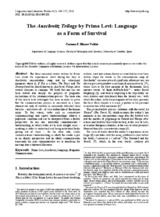Mostrar el registro sencillo del ítem
The Auschwitz Trilogy by Primo Levi: Language as a Form of Survival
| dc.contributor.author | Blanco Valdés, Carmen F. | |
| dc.date.accessioned | 2016-03-03T12:38:31Z | |
| dc.date.available | 2016-03-03T12:38:31Z | |
| dc.date.issued | 2016 | |
| dc.identifier.issn | 2331-6438 | |
| dc.identifier.uri | http://hdl.handle.net/10396/13291 | |
| dc.description.abstract | The three memorial works written by Primo Levi about the experiences lived during his stay at Auschwitz concentration camp and his subsequent memories about it, If This is a Man, The Truce and The Drowned and the Saved, known as Auschwitz Trilogy, have several elements in common. We think that one has not been delved into deeply: the purpose of pragmatic mechanisms of the communication process. The main aim of this article is to investigate this issue in order to prove that the communication process is conceived as a basic element not only of survival (a commonly defended idea) but also – and above all – of a reconstruction of the human entity. To that extent, verbs such as comunicare (communicating) and capire (understanding) achieve a polysemic condition and can be interpreted from a double perspective. On one side, individual communication / understanding, in which verbs act in their straight sense – speaking in order to understand and being understood helps getting out of chaos -. On the other side, choral communication / understanding, in which the reader is put in an alterity perspective and in which communication transcends the pure communicative act to transform the message into a universal discourse. | es_ES |
| dc.format.mimetype | application/pdf | es_ES |
| dc.language.iso | eng | es_ES |
| dc.rights | https://creativecommons.org/licenses/by-nc-nd/4.0/ | es_ES |
| dc.source | Linguistics and Literature Studies 4(2): 149-157, 2016 | es_ES |
| dc.subject | Primo Levi | es_ES |
| dc.subject | Auschwitz | es_ES |
| dc.subject | Language | es_ES |
| dc.subject | Pragmatic Communication | es_ES |
| dc.title | The Auschwitz Trilogy by Primo Levi: Language as a Form of Survival | es_ES |
| dc.type | info:eu-repo/semantics/article | es_ES |
| dc.rights.accessRights | info:eu-repo/semantics/openAccess | es_ES |

